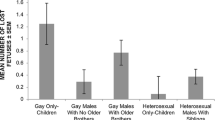Abstract
There is some evidence for a genetic influence on sexual orientation. However, gay men have fewer children than heterosexual men. Increased fecundity in the biological relatives of gay men could offset this selection pressure. We measured family size in gay (n = 301) and heterosexual (n = 404) men, attending clinics for sexually transmitted infections. The main outcome measure was the number of each man’s uncles and aunts, first cousins, siblings, nephews and nieces, and his own children. With the exception of the participants’ own offspring, mean family size of each category of relatives was significantly larger for gay men (paternal and maternal total OR = 1.02, CI = 1.01–1.03). This remained the case after adjustment for other predictors of family size (paternal and maternal total OR = 1.02, CI = 1.00–1.03). We found increased fecundity in the relatives of gay men and this is one explanation of how a genetic influence might persist in spite of reduced reproductive fitness in the gay phenotype. There are, however, a number of alternative explanations for our finding, including unknown psychological and social factors, which might mediate the association between family size and sexual orientation.
Similar content being viewed by others
References
Bailey, J. M., & Pillard, R. C. (1991). A genetic study of male sexual orientation. Archives of General Psychiatry, 48, 1089–1096.
Bailey, J. M., Pillard, R. C., Dawood, K., Miller, M. B., Farrer, L. A., Trivedi, S., et al. (1999). A family history study of male sexual orientation using three independent samples. Behavior Genetics, 29, 79–86.
Bell, A. P., & Weinberg, M. S. (1978). Homosexualities: A study of diversity among men and women. New York: Simon & Schuster.
Blanchard, R. (2001). Fraternal birth order and the maternal immune hypothesis of male homosexuality. Hormones and Behavior, 40, 105–114.
Blanchard, R., Zucker, K. J., Cavacas, A., Allin, S., Bradley, S. J., & Schachter, D. C. (2002). Fraternal birth order and birth weight in probably prehomosexual feminine boys. Hormones and Behavior, 41, 321–327.
Bogaert, A. F. (1998). Birth order and sibling sex ratio in homosexual and heterosexual non-white men. Archives of Sexual Behavior, 27, 467–473.
Cantor, J. M., Blanchard, R., Paterson, A. D., & Bogaert, A. F. (2002). How many gay men owe their sexual orientation to fraternal birth order? Archives of Sexual Behavior, 31, 63–71.
Hamilton, W. (1964). The genetical evolution of social behavior: I. Journal of Theoretical Biology, 7, 1–16.
Jones, M. B., & Blanchard, R. (1998). Birth order and male homosexuality: An extension of Slater’s index. Human Biology, 70, 775–787.
Kendler, K. S., Thornton, L. M., Gilman, S. E., & Kessler, R. C. (2000). Sexual orientation in a US national sample of twin and non-twin sibling pairs. American Journal of Psychiatry, 157, 1843–1846.
Kinsey, A. C., Pomeroy, W. B., & Martin, C. E. (1948). Sexual behavior in the human male. Philadelphia: W. B. Saunders.
Miller, E. M. (2000). Homosexuality, birth order, and evolution toward an equilibrium reproductive economics of homosexuality. Archives of Sexual Behavior, 29, 1–34.
Office of Population Censuses and Surveys. (1990). Standard occupational classification. London: Her Majesty’s Stationery Office.
Pillard, R. C., & Bailey, J. M. (1998). Human sexual orientation has a heritable component. Human Biology, 70, 347–365.
Turner, W. J. (1995). Homosexuality type 1: An Xq28 phenomenon. Archives of Sexual Behavior, 24, 109–134.
Wilson, E. O. (1975). Sociobiology: The new synthesis. Cambridge, MA: Harvard University Press.
Author information
Authors and Affiliations
Corresponding author
Rights and permissions
About this article
Cite this article
King, M., Green, J., Osborn, D.P.J. et al. Family Size in White Gay and Heterosexual Men. Arch Sex Behav 34, 117–122 (2005). https://doi.org/10.1007/s10508-005-1006-8
Received:
Revised:
Accepted:
Issue Date:
DOI: https://doi.org/10.1007/s10508-005-1006-8




